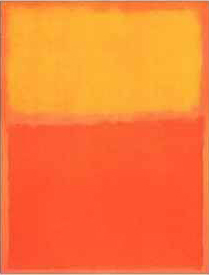
Orange and Yellow

|
Mark Rothko was an important member of the New York School of the mid-20th century (including Jackson Pollock and Willem de Kooning, among others). This group came to be knows as the Abstract Expressionists. Though Rothko belonged to this group, his work was not essentially Expressionist in nature. Rothko did not try to express; he wanted to transcend.
"Transcendental experience", as he called it, was the central idea of his art. It was supposed to be a release from the banal, a rising above habitual experience for the viewer. In his works, he eschewed any references to nature, symbols, or signs; many works did not even have titles. Rothko thought these were nothing more than obstacles to the pure presentation of his idea. In turn, his paintings indeed transcend history and context: they are not confined by or dependent on the period in which they were painted.
Rothko's more common style is employed well here, in Orange and Yellow. True to form, the painting has an immediacy, a gripping presence. It is also essentially enigmatic, very much open to interpretation (Rothko's paintings, in their day, ignited a period of excessive commentary and dubious analyses). Like the calm before the storm, the painting is peaceful but charged—its power is palpable, and there is more there than just beautiful, sensual interplay of color.
In terms of color, Rothko often layered color on color, as he did here, placing the bright, rich yellow and orange on a background of duller, softer orange. The result is a remarkable effect of light: the radiance of the yellow interacts with the smoldering orange, and both are tempered by the gentle orange background. The entire painting is imbued with a luminous quality. Rothko himself insisted that he was more interested in light than color.












